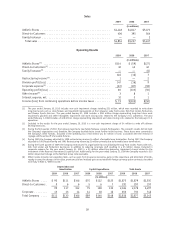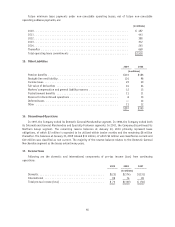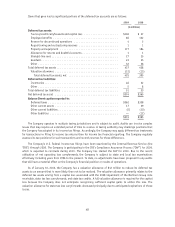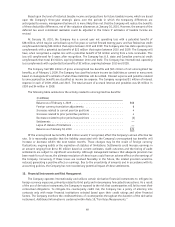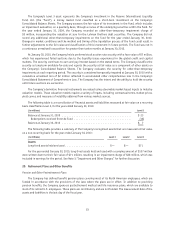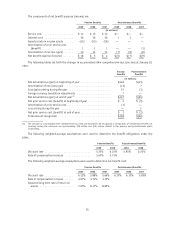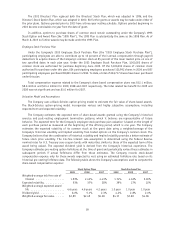Foot Locker 2009 Annual Report Download - page 67
Download and view the complete annual report
Please find page 67 of the 2009 Foot Locker annual report below. You can navigate through the pages in the report by either clicking on the pages listed below, or by using the keyword search tool below to find specific information within the annual report.
Based upon the level of historical taxable income and projections for future taxable income, which are based
upon the Company’s three-year strategic plans, over the periods in which the temporary differences are
anticipated to reverse, management believes it is more likely than not that the Company will realize the benefits
of these deductible differences, net of the valuation allowances at January 30, 2010. However, the amount of the
deferred tax asset considered realizable could be adjusted in the future if estimates of taxable income are
revised.
At January 30, 2010, the Company has a current year net operating loss with a potential benefit of
$38 million, which may be carried back up to five years or carried forward twenty years; and has federal tax credit
carryforwards totaling $36 million that expire between 2017 and 2029. The Company also has state operating loss
carryforwards with a potential tax benefit of $22 million that expire between 2010 and 2029. The Company will
have, when recognized, a capital loss with a potential benefit of $5 million arising from a note receivable. This
loss will carryforward for 5 years after recognition. The Company has U.S. state and Canadian provincial credit
carryforwards that total $3 million, expiring between 2010 and 2022. The Company has international operating
loss carryforwards with a potential tax benefit of $2 million, expiring between 2010 and 2028.
The Company had $58 million of gross unrecognized tax benefits and $55 million of net unrecognized tax
benefits, as of February 1, 2009. The Company has classified certain income tax liabilities as current or noncurrent
based on management’s estimate of when these liabilities will be settled. Interest expense and penalties related
to unrecognized tax benefits are classified as income tax expense. The Company recognized $1 million of interest
expense in each of 2009, 2008, and 2007. The total amount of accrued interest and penalties was $5 million in
2009 and $4 million in 2008.
The following table summarizes the activity related to unrecognized tax benefits:
(in millions)
Balance as of February 1, 2009 .............................. $58
Foreign currency translation adjustments ...................... 6
Increases related to current year tax positions ................... 4
Increases related to prior period tax positions ................... 4
Decreases related to prior period tax positions ................... (2)
Settlements .......................................... —
Lapse of statute of limitations .............................. —
Balance as of January 30, 2010 ............................. $70
Of the unrecognized tax benefits, $68 million would, if recognized, affect the Company’s annual effective tax
rate. It is reasonably possible that the liability associated with the Company’s unrecognized tax benefits will
increase or decrease within the next twelve months. These changes may be the result of foreign currency
fluctuations, ongoing audits or the expiration of statutes of limitations. Settlements could increase earnings in
an amount ranging from $0 to $5 million based on current estimates. Audit outcomes and the timing of audit
settlements are subject to significant uncertainty. Although management believes that adequate provision has
been made for such issues, the ultimate resolution of these issues could have an adverse effect on the earnings of
the Company. Conversely, if these issues are resolved favorably in the future, the related provision would be
reduced, generating a positive effect on earnings. Due to the uncertainty of amounts and in accordance with its
accounting policies, the Company has not recorded any potential impact of these settlements.
18. Financial Instruments and Risk Management
The Company operates internationally and utilizes certain derivative financial instruments to mitigate its
foreign currency exposures, primarily related to third party and intercompany forecasted transactions. As a result
of the use of derivative instruments, the Company is exposed to the risk that counterparties will fail to meet their
contractual obligations. To mitigate the counterparty credit risk, the Company has a policy of entering into
contracts only with major financial institutions selected based upon their credit ratings and other financial
factors. The Company monitors the creditworthiness of counterparties throughout the duration of the derivative
instrument. Additional information is contained within Note 19, ‘‘Fair Value Measurements.’’
49


